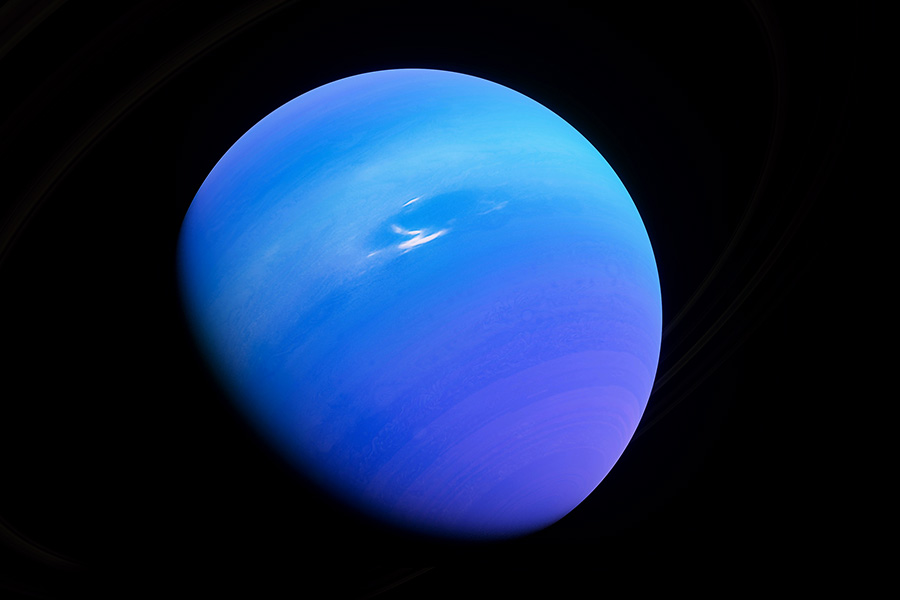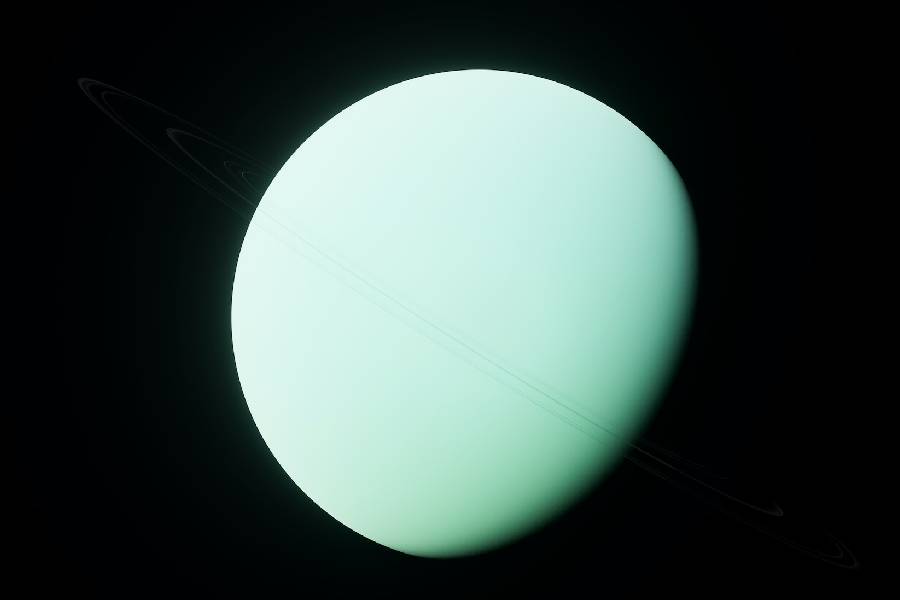Hovering nearly 3 billion miles from the Sun’s warmth, the mysterious icy world of Uranus reveals little about itself at first glance. But it holds many wonders for those bold enough to venture deeper. Though the seventh planet from the Sun was discovered clearly back in 1781, many of Uranus’ traits remain enigmatic even today.
However, peering through advanced telescopes and dispatching robotic explorers offers glimpses into its nature—allowing us to assemble a multifaceted picture of this quirky celestial sphere. What made up this chilly giant? How was this planet formed, and what sculpted its puzzling landscape over the eons?
In this comprehensive article, we will tackle these questions and more as we uncover what makes ice-cloaked Uranus so mesmerizing. So, join us on an exploratory tour through the many Uranus characteristics.
Uranus Characteristics
Uranus, the seventh planet from the Sun, boasts distinct characteristics that set it apart in our solar system. This gas giant is enveloped by a bluish-green atmosphere due to methane and is adorned with 13 faint rings.
Uranus exhibits an extreme axial tilt, which leads to unusual seasons and lighting conditions. It’s accompanied by 27 known moons and features a complex, asymmetric magnetic field. The planet’s frigid temperatures, dipping to -224 degrees °C (-371 °F), contribute to its unique nature.

Physical Characteristics of Uranus
Size, mass, and volume of Uranus
With a radius of over 15,000 miles, Uranus is approximately four times wider than Earth. Its mass is about 14.5 times that of our home planet. This makes Uranus the 7th largest planet by mass and the 3rd largest by size in our solar system.
Uranus is much smaller and less massive than the gas giants Jupiter and Saturn. Jupiter could hold over 1,300 Earths inside it, while Saturn could fit around 750 Earths.
Uranus can only hold about 63 Earths within its volume. However, Uranus still dwarfs us in size and mass overall. To be precise, its volume is around 63 times greater than Earth’s.
Composition of its atmosphere
Like the other gas giants, Uranus’ atmosphere consists of molecular hydrogen and atomic helium. But uniquely, it also contains around 2.3% methane gas. This methane is what gives Uranus its distinct greenish-blue color.
The methane molecules absorb certain wavelengths of red light, leading to blue hues when that light is reflected back into space. Additionally, there are solid methane ice crystals suspended in the upper layers of the atmosphere.
As sunlight passes through these cloud layers, the methane particles scatter the light, creating a pale, hazy appearance around the planet’s rim. This makes parts of Uranus look washed out and featureless.
Unusual axial tilt and rotation
The most striking aspect of Uranus is its extreme tilt, with an axis inclination of 97.77 degrees. This means Uranus essentially orbits the Sun on its side, rotating like a rolling ball instead of spinning vertically like the other planets.
This unusual tilt results in strange seasons on Uranus. Over the course of its 84-year orbit, each pole faces directly toward the Sun for around 42 years before switching to face away for 42 years of darkness.
Scientists have proposed various theories to explain this remarkable tilt, such as a giant impact knocking Uranus on its side. Yet, more observations are needed to unravel the mystery of Uranus’s orientation.
Atmosphere and Climate
Bluish-green appearance
As mentioned earlier, Uranus owes its bluish-green hue to the presence of methane gas in its atmosphere. Methane strongly absorbs red light at wavelengths around 600-750 nanometers while reflecting bluer wavelengths of light.
This gives Uranus a distinctly aquamarine color. Additionally, there are likely hydrogen sulfide ice crystals at deeper levels of the atmosphere. When sunlight passes through these deeper cloud decks, blue light is scattered more strongly, enhancing Uranus’ blue tint when viewed from space.
Extreme temperatures on Uranus
Uranus is an icy planet with an average temperature of -197 °C (-322.6 °F). That makes it even colder than Neptune. Uranus’s great distance from the Sun is the main reason behind these frigid temperatures.
At an average of 1.8 billion miles from the Sun, Uranus receives only around 1/400th the sunlight that Earth does. Furthermore, Uranus radiates more energy than it receives as the leftover heat from its formation bleeds out into space. Internal heat sources are weak, preventing convection currents from transporting heat upward.
Role of methane in the atmosphere
In addition to its role in Uranus’s color, methane also shapes the planet’s temperature profile. Methane ice absorbs radiation from the Sun and re-radiates it at different wavelengths, trapping heat in the lower atmosphere.
This helps maintain a temperature gradient, with the upper atmosphere at a chilly -216 °C (-356.8 °F) and warmer lower layers at -197 °C (-322.6 °F). Complex heating and cooling methane cycles between gas and liquid states may also help move energy around internally. Also, methane similarly affects other giants like Jupiter and Saturn where it occurs.
Rings and Moons
Overview of Uranus’s ring system
Uranus has its ring system; however, it’s less well-known than Saturn’s. Uranus has 13 distinct rings that orbit around its equator. These rings are composed of extremely dark particles, likely organic compounds processed by radiation. That’s different from Saturn’s brighter icy rings.
Some small moons, like Cordelia and Ophelia, help shepherd and keep the rings in place. The rings are faint and hard to spot since they don’t reflect much visible light. But we’ve been able to study them using infrared and radio observations. The Uranian rings offer clues into the system’s complex gravitational dance.
Exploration of significant moons
Uranus has over two dozen moons, but the five largest are particularly fascinating. Titania is the biggest, an icy world cut by deep canyons and valleys. Little is known about the surface since it’s veiled in haze. Oberon, just a bit smaller, shows a mysterious reddish tint. Intriguingly, its surface is one of the most cratered in the solar system.
Venturing deeper into the Uranian moons, we find pearly Ariel. It boasts the brightest, youngest surface dotted with canyons and fault valleys. Nearby Umbriel is darker, with ancient cratered terrain.
However, the most remarkable moon is Miranda. Its jumbled landscape resembles a patchwork, evidence of dramatic reshaping from tectonic forces. With icy erupting geysers and strange scarps called coronae, Miranda continues to offer up surprises.

Magnetic Field and Magnetosphere
Uranus’s magnetic field
Uranus has a very unique magnetic field compared to other planets. It is tilted nearly 60 degrees from the planet’s rotation axis and is also offset from the center of the planet. This means it does not emanate from Uranus’s core but rather from a displaced point deeper in the icy mantle.
The magnetic field is also not aligned symmetrically around the rotation axis. Scientists are still determining how this irregular and asymmetric field is generated. Despite its odd alignment, the magnetic field still produces a magnetosphere around Uranus.
How the magnetosphere interacts with solar wind
Uranus’s magnetosphere is the region around the planet dominated by its magnetic field. It acts as a shield against the solar wind, which is the stream of charged particles emanating from the Sun.
The solar wind compresses the side of the magnetosphere that faces the Sun, shaping it into a long magnetotail on the opposite side, stretching millions of miles behind Uranus.
Moreover, fluctuations in the solar wind lead to dynamics like magnetic reconnection, where energy from the Sun accelerates charged particles in the magnetosphere. Understanding Uranus’s magnetosphere provides insights into the planet’s unusual internal structure and rotation.
Comparative Planetary Analysis
Unlike Jupiter and Saturn, Uranus is an ice giant rather than a true gas giant. This means it has a higher concentration of elements like oxygen, carbon, nitrogen, hydrogen, and helium. Uranus is much less massive than Jupiter and Saturn. Jupiter could hold over 1,300 Earths while Saturn can hold around 750 Earths.
However, Uranus can only hold about 63 Earths within its volume. Jupiter and Saturn also have intense internal heat, unlike the frigid Uranus, which leads to more storm activity on their surfaces. Plus, the rings of Uranus are darker and narrower than Saturn’s extensive bright rings.
What makes Uranus unique?
Uranus’s extreme 98-degree axial tilt makes it unique among the planets, as does its resulting sideways rotation. Uranus is the only planet whose magnetic axis is not close to the rotational axis.
The irregular magnetic field suggests Uranus has a different internal structure than other giants. Uranus also orbits the Sun far more distantly than Jupiter and Saturn. This leads to its extremely cold temperatures and slow orbit. Uranus’ blue-green color due to atmospheric methane is also distinct in the solar system.
Mysteries and Ongoing Research
Unresolved questions or mysteries about Uranus
There are still many mysteries around Uranus left to uncover. Scientists are unsure how it obtained its extreme axial tilt and resulting unusual rotation. The mechanisms for Uranus’ skewed magnetic field and internal heat transfer are also unknown.
Uranus seems to lack the atmospheric features seen on Jupiter and Saturn, suggesting an incomplete understanding of its weather and climate. Many questions remain regarding its formation history, ring dynamics, and the surface properties of its moons.
Missions and research related to Uranus
Some upcoming missions could shed light on Uranus’ mysteries. The European Space Agency had a Uranus Pathfinder mission to study the planet’s atmosphere, rings, magnetosphere, and moons.
NASA also has a proposed Uranus Orbiter and Probe mission in its long-term plans. Ground-based telescopes like Keck, Hubble, and future space telescopes will also enable more detailed remote observations.

Frequently Asked Questions
What is the weather like on Uranus?
The weather on Uranus is overall relatively calm and featureless. The planet is extremely cold with minimum atmospheric temperatures of -224 °C (371.2°F). It does not have significant internal heat like the other gas giants.
As a result, there is little convection and mixing to drive interesting cloud features and storm activity typically associated with turbulent weather.
Are there storms on Uranus?
While Uranus does not have storms as massive and long-lasting as those seen on Jupiter and Saturn, some transient storms have been observed. There were spotted a few relatively small dark spot storms persisting in the planet’s atmosphere.
However, no storms nearly as dramatic as Jupiter’s Great Red Spot have been detected on Uranus’s mostly bland and placid surface.
Are there any notable weather patterns or atmospheric phenomena on Uranus?
There are a few subtle atmospheric features of note. Its atmosphere displays extremely high-speed winds of up to 560 mph, consistent with a rapid rotation rate of 17 hours. Interesting brightness patterns have been seen while the planet orbits, suggesting seasonal changes.
Hydrocarbon hazes, ice crystal clouds, and auroras also occur in the atmosphere, revealing this icy giant’s complex atmospheric chemistry and dynamics. But overall, Uranus exhibits a uniform and calm weather system compared to other outer planets.
Conclusion
Uranus stands out for its uniqueness. This icy giant world twirls sideways around the Sun, with each pole facing continuous sunlight or darkness for decades. Despite its great distance, methane in Uranus’ atmosphere makes it shine like a cool aquamarine.
Thirteen faint rings and a bevy of moons encircle the planet, tilted by its axial inclination. Beneath its bland façade, strange magnetic forces and energetic winds swirl.
The story of Uranus is one of expanding frontiers, for its discovery in 1781 doubled the size of the known solar system. Studying Uranus’s characteristics over the past two centuries has uncovered more mysteries than answers.
Much remains unknown about how Uranus formed, why it rotates sideways, and what drives its puzzling magnetic field. Yet, with each new revelation, our grasp of planetary science grows.

